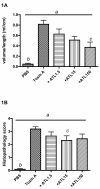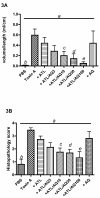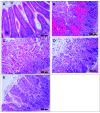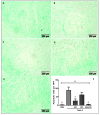Effects of adenosine A₂A receptor activation and alanyl-glutamine in Clostridium difficile toxin-induced ileitis in rabbits and cecitis in mice
- PMID: 22264229
- PMCID: PMC3323464
- DOI: 10.1186/1471-2334-12-13
Effects of adenosine A₂A receptor activation and alanyl-glutamine in Clostridium difficile toxin-induced ileitis in rabbits and cecitis in mice
Abstract
Background: Severe Clostridium difficile toxin-induced enteritis is characterized by exuberant intestinal tissue inflammation, epithelial disruption and diarrhea. Adenosine, through its action on the adenosine A2A receptor, prevents neutrophillic adhesion and oxidative burst and inhibits inflammatory cytokine production. Alanyl-glutamine enhances intestinal mucosal repair and decreases apoptosis of enterocytes. This study investigates the protection from enteritis by combination therapy with ATL 370, an adenosine A2A receptor agonist, and alanyl-glutamine in a rabbit and murine intestinal loop models of C. difficile toxin A-induced epithelial injury.
Methods: Toxin A with or without alanyl-glutamine was administered intraluminally to rabbit ileal or murine cecal loops. Animals were also given either PBS or ATL 370 parenterally. Ileal tissues were examined for secretion, histopathology, apoptosis, Cxcl1/KC and IL-10.
Results: ATL 370 decreased ileal secretion and histopathologic changes in loops treated with Toxin A. These effects were reversed by the A2A receptor antagonist, SCH 58261, in a dose-dependent manner. The combination of ATL 370 and alanyl-glutamine significantly further decreased ileal secretion, mucosal injury and apoptosis more than loops treated with either drug alone. ATL 370 and alanyl-glutamine also decreased intestinal tissue KC and IL-10.
Conclusions: Combination therapy with an adenosine A2A receptor agonist and alanyl-glutamine is effective in reversing C. difficile toxin A-induced epithelial injury, inflammation, secretion and apoptosis in animals and has therapeutic potential for the management of C. difficile infection.
Figures






Similar articles
-
Contribution of adenosine A(2B) receptors in Clostridium difficile intoxication and infection.Infect Immun. 2012 Dec;80(12):4463-73. doi: 10.1128/IAI.00782-12. Epub 2012 Oct 8. Infect Immun. 2012. PMID: 23045479 Free PMC article.
-
Effect of novel A2A adenosine receptor agonist ATL 313 on Clostridium difficile toxin A-induced murine ileal enteritis.Infect Immun. 2006 May;74(5):2606-12. doi: 10.1128/IAI.74.5.2606-2612.2006. Infect Immun. 2006. PMID: 16622196 Free PMC article.
-
Caspase and bid involvement in Clostridium difficile toxin A-induced apoptosis and modulation of toxin A effects by glutamine and alanyl-glutamine in vivo and in vitro.Infect Immun. 2006 Jan;74(1):81-7. doi: 10.1128/IAI.74.1.81-87.2006. Infect Immun. 2006. PMID: 16368960 Free PMC article.
-
Intestinal epithelial restitution after TcdB challenge and recovery from Clostridium difficile infection in mice with alanyl-glutamine treatment.J Infect Dis. 2013 May 15;207(10):1505-15. doi: 10.1093/infdis/jit041. Epub 2013 Jan 28. J Infect Dis. 2013. PMID: 23359592 Free PMC article.
-
The enterotoxicity of Clostridium difficile toxins.Toxins (Basel). 2010 Jul;2(7):1848-80. doi: 10.3390/toxins2071848. Epub 2010 Jul 14. Toxins (Basel). 2010. PMID: 22069662 Free PMC article. Review.
Cited by
-
Infectious Tolerance as Seen With 2020 Vision: The Role of IL-35 and Extracellular Vesicles.Front Immunol. 2020 Aug 26;11:1867. doi: 10.3389/fimmu.2020.01867. eCollection 2020. Front Immunol. 2020. PMID: 32983104 Free PMC article. Review.
-
Contribution of adenosine A(2B) receptors in Clostridium difficile intoxication and infection.Infect Immun. 2012 Dec;80(12):4463-73. doi: 10.1128/IAI.00782-12. Epub 2012 Oct 8. Infect Immun. 2012. PMID: 23045479 Free PMC article.
-
The P2Y6 receptor mediates Clostridium difficile toxin-induced CXCL8/IL-8 production and intestinal epithelial barrier dysfunction.PLoS One. 2013 Nov 22;8(11):e81491. doi: 10.1371/journal.pone.0081491. eCollection 2013. PLoS One. 2013. PMID: 24278446 Free PMC article.
-
The host immune response to Clostridium difficile infection.Ther Adv Infect Dis. 2013 Feb;1(1):19-35. doi: 10.1177/2049936112472173. Ther Adv Infect Dis. 2013. PMID: 25165542 Free PMC article. Review.
-
Investigational Treatment Agents for Recurrent Clostridioides difficile Infection (rCDI).J Exp Pharmacol. 2020 Oct 9;12:371-384. doi: 10.2147/JEP.S242959. eCollection 2020. J Exp Pharmacol. 2020. PMID: 33116952 Free PMC article. Review.
References
-
- Muto CA, Pokrywka M, Shutt K, Mendelsohn AB, Nouri K, Posey K, Roberts T, Croyle K, Krystofiak S, Patel-Brown S. et al.A large outbreak of Clostridium difficile-associated disease with an unexpected proportion of deaths and colectomies at a teaching hospital following increased fluoroquinolone use. Infect Control Hosp Epidemiol. 2005;26:273–280. doi: 10.1086/502539. - DOI - PubMed
-
- Johnson S, Homann SR, Bettin KM, Quick JN, Clabots CR, Peterson LR, Gerding DN. Treatment of asymptomatic Clostridium difficile carriers (fecal excretors) with vancomycin or metronidazole. A randomized, placebo-controlled trial. Ann Intern Med. 1992;117:297–302. - PubMed
Publication types
MeSH terms
Substances
Grants and funding
LinkOut - more resources
Full Text Sources
Miscellaneous

